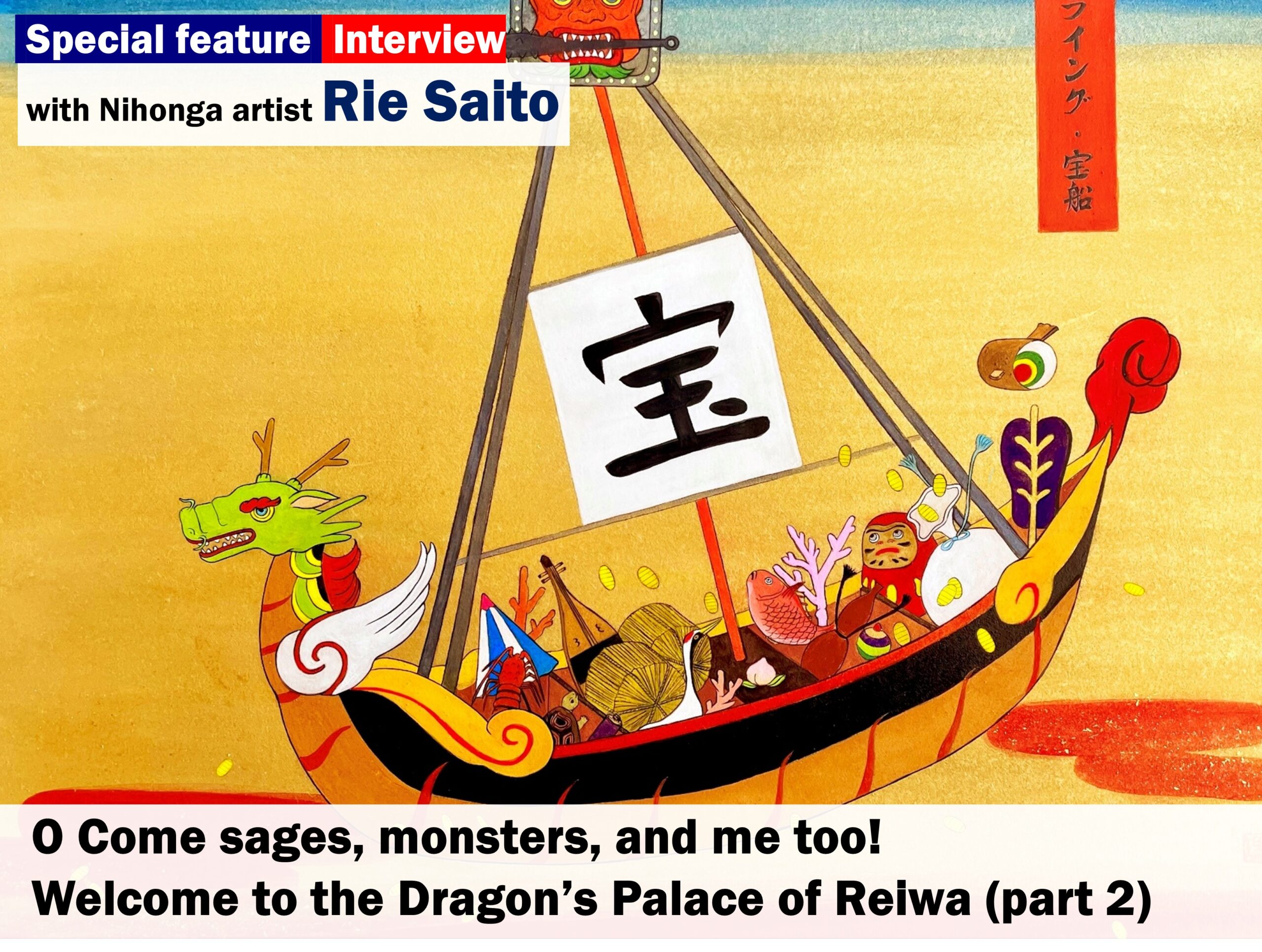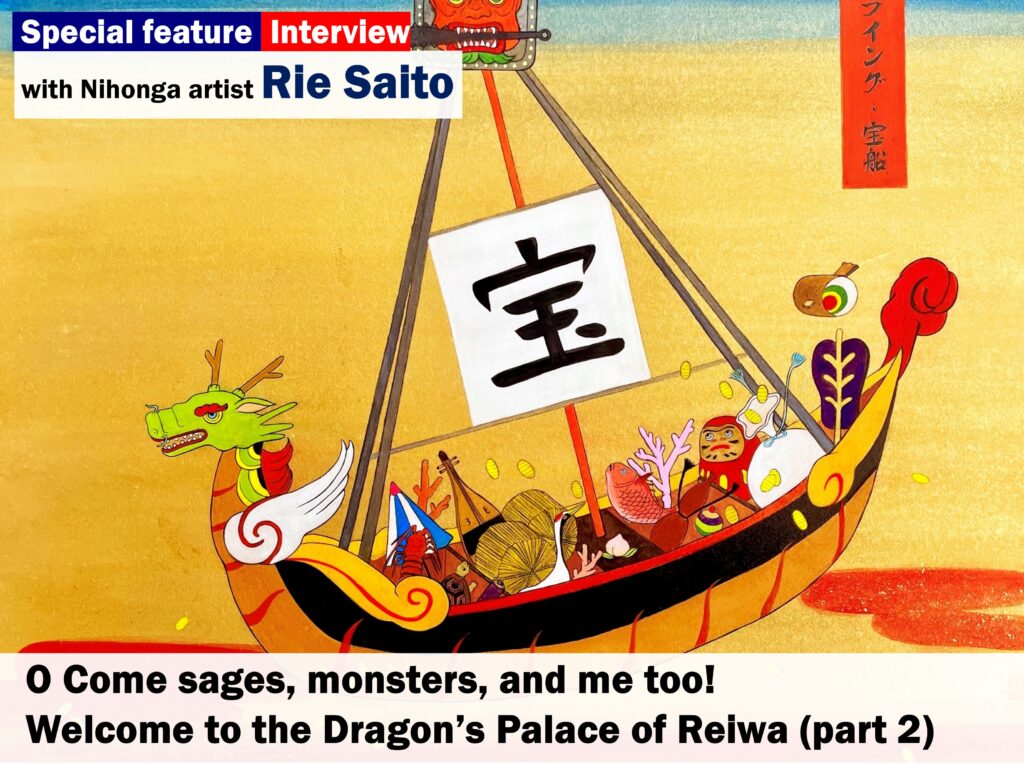
Interview with Nihonga artist, Rie Saito. Please enjoy reading the second half of this interview by the FFD editorial team!
Interview with Nihonga artist Rie Saito (part 2)
One day, an image of a kappa with a sushi on its head appeared in my mind
You’re well known for painting yokai monsters and mermaids. Can you tell us about the story behind that?
While preparing for college entrance exams, I was solely focused on my exam sketches. Exam sketches test your ability to make realistic drawings of what’s put in front of you, which was completely different from what I wanted to draw. Once I started college and the teachers told us to draw what we wanted to though, I had a difficult time figuring out what it was that I wanted to draw. Then one day, an image appeared in my mind of a kappa (turtle-like spirit from Japanese folklore) with sushi on its head. It was such a bizarre image that I tried to get it out of my mind, but the image kept coming back.

What is this?
Landscape drawings were my go-to back then, but the image of the kappa was too vivid and I couldn’t think of drawing anything else for my assignments. Resigned, I decided to paint him, but even when I finished the painting, I couldn’t understand why it had appeared in my mind. I decided that the kappa was what I needed. In the beginning, I made various types of kappa paintings, such as putting shaved ice on their heads and switching out the sushi toppings. I was just enjoying the experience and hadn’t shown it to anyone else. Two weeks later, I was told there would be a special exhibition in Asakusa featuring yokai monsters, so I decided to display my works there.

There were yokai fans at the exhibition and they liked my kappa art as well. My first Nihonga painting that sold was at the Tokyu Hands exhibition in Shibuya. A Nihonga painting (SM sized 22.7cm x 15.8cm) of a kappa sold for 4,000yen. At the time, I didn’t know what the fair price was for a professional painter, but I will never forget the feeling of selling my first work of art.
Gegege no Kitaro was my first crush
Have you always been a big fan of yokai?
Yes, I’ve always liked yokai, but I never thought of painting one until the kappa. I remember really liking the animation Gegege no Kitaro as a young child, and Kitaro was my first crush. I think I appreciated how Kitaro never got angry at Nezumi Otoko, no matter how terrible Nezumi Otoko was to him.
So, you like Kitaro not because he was a yokai, but for his big heart.
That’s right. I was more of a landscape artist, so it wasn’t like I had an affinity for yokai.
Were you interested in drawing anything other than kappa?
After the kappa paintings were sold, I had a sudden urge to draw mermaids. This was another one of those images that just came to me one day. This wasn’t any western mermaid, but a Japanese one.
The yokai monsters that appeared in a little window in my mind
I started drawing mermaids from the image in my mind. I really wanted to exhibit this piece and submitted my painting to the Contemporary Children’s Drawing Exhibition at the Tokyo Metropolitan Art Museum. For the first time, my painting was selected and even won an honorable mention. I was pleased that people could now see the painting that had appeared in my mind. Ever since then, I’ve been showing my paintings at the Contemporary Children’s Art Exhibition.

Congratulations, your first honorable mention at your first public exhibition entry. That’s wonderful.
Thank you. The experience gave me the confidence I needed. No one had ever seen a Japanese style mermaid, and I think that helped. Looking back now, the kappa and mermaid must have popped into my mind at a critical juncture in my career and prodded me forward. Their images came out of nowhere, and I just had to paint them because I couldn’t get anything else done. You know how on some TV shows, there’s a picture-in-picture that displays a small screen in the corner of the main screen? That’s what was happening in my head, and I couldn’t close that screen no matter how hard I tried. Painting these images have helped me to become a better artist. It’s such a bizarre story, but it’s very meaningful to me.
Your story reminds me of you, as a young girl drawing only what you wanted to draw. I heard that you were submitting your paintings at art auctions while you were a student?
I challenged myself to try a variety of things in college because I desperately wanted to make up for the six years I spent preparing for entrance exams. One of the things was to submit my painting to art auctions. Since my university was located in Kyoto, I was eligible to apply for the Kyoto Student Art auction run by AG Holdings. My work was one of those selected, and it made its debut there.

Unfortunately, my speech at the auction was a disaster. My mind went blank since I was so nervous speaking in front of so many people, and I barely remember what I said… Even then, there were generous people who bid for my item, and this gave me a lot of confidence.
Suppressing my true self and painting during the years spent preparing for college
I always enjoy the fresh ideas your paintings offer, I see that you bring together elements that are rarely seen together.
I appreciate you saying that. When I see a flower, I reflect on its beauty, but the beauty itself doesn’t compel me to paint it. I like to paint pictures that only I can paint, and am delighted when I find an unexpected combination of things to paint. I distinctly remember being deeply moved as a student when I saw the vivid depiction of mythical beings in “The Wind and Thunder Gods” by Sotatsu Tawaraya.
There’s a sense of humor in many of your paintings.
I’m glad you see that. I think my true feelings surface in my paintings. Take one of my paintings with the carp relaxing on the cutting board, for example.
My true feelings surfaced at my busiest
My schedule was packed with exhibitions at the time. I was working on another painting at the time, but again, this image of a carp relaxing on a cutting board kept popping into the small window in my mind. I showed my mother the drawing I made of it, telling her in my most annoying voice, “how dare the carp casually relax and lie there nonchalantly when I’m incredibly busy!”

My mother liked it, encouraging me, “This is great! You should make this into one of your pieces”, and this painting is the result.
Your buried desire to sit back and relax is front and center in this painting.
That’s right. This painting came about because I was exhausted and wanted to rest. It seems that the more I suppress my true feelings, the more another part of me emerges insistently to make sure I don’t ignore it. During my test taking years, I felt pressured to make an exam sketch if I wanted to draw, but I realized that was just suppressing my true feelings. I’d like to think that I’ve gotten better at listening to my true feelings and painting from the heart.
Do you have anything you’d like to convey to the people who view your paintings?
Since I express my feelings through my paintings, I think people can understand what I’m trying to communicate. But I hope that my art will help those who are suffering from having to push their own feelings to the side like I was, to help them “break the spell and release their feelings”. I want to show others how freeing and joyful it can be to open up and communicate their feelings. It might take time for people to understand the art I’m drawing from my imagination, but I want to keep believing in the power of my own imagination.
I was aiming for the Ryu-Gu-Jo (Dragon’s Palace)!
Many of your paintings incorporate water or river motifs.
It’s as if I’m piecing together the puzzle myself, but when I try to connect all the motifs that have come to my mind so far, I notice that what they all have in common is they’re all some type of water creature. The most recent image that came to my mind was “The Turtle with a Ryu-Gu-Jo (Dragon’s Palace) on its back”. That’s when I realized that the Ryu-Gu-Jo was what I was aiming for all this time!
The theme of your solo exhibition at Isetan Urawa store in December, 2022 is “Reiwa’s Ryu-Gu-Jo”.
That’s right. I draw a wide variety of subjects in my paintings. They range from yokai-like creatures such as kappa and mermaids, to more heavenly deities like dragons and phoenixes. In my mind, the distinction between good and evil (yokai) is something that humans intentionally made, but I don’t think we should be the ones to be the judge between good and evil. The definition of good and bad existences vary depending on the religion and customs of different regions. It doesn’t make sense to me that we worship beings that help humans as gods, and treat the creepy and unaesthetic beings as yokai (monsters). I created Ryu-Gu-Jo in hopes that it could be a place where all fantastical creatures are accepted without judgment. My ideal would be somewhere similar to the world of Gegege no Kitaro, where humans and yokai can easily come and go as they like.

I just remembered that Kitaro is your first crush.
Yes, he is! In my mind, Ryu-Gu-Jo is a mysterious place where time flows at a different pace from that on earth. This is one of the reasons why my paintings incorporate modern motifs into old tales and legends. In literature from the Edo period, mermaids make an appearance, but not Nishikigoi mermaids. Nishikigoi is said to have originated in the mid-Edo era and popularized in the Taisho and Showa periods, thus painters from the Edo era wouldn’t have been able to draw them in the paintings. If Nishikigoi had become widespread in the Edo period, Ukiyoe artists would have painted a lot of them! The Nishikigoi mermaid is a motif I can draw as an artist living in the Reiwa period. I would like to present art based on the wonderful literature left behind by our forerunners, but updated in a modern style in my own interpretation. This is what I would like to do.
A modern day “Reiwa Ryu-Gu-Jo”
I’m currently working on the Reiwa Ryu-Gu-Jo as the culmination of my past works. At the solo exhibition, you’ll find mermaids, turtles, kappa, carps and other unusual creatures speaking to you with a sense of humor. I hope that you’ll listen to their voices and enjoy the Reiwa Ryu-Gu-Jo when you come and visit.
Thank you for your time today!
(Interviewer, FFD editorial team)
The process of creating a painting from start to finish ~ we asked Nihonga artist, Rie Saito ~
When we think about Nihonga paintings, we often associate them with unique painting styles and materials. In this interview, we ask Nihonga artist, Rie Saito, about the process of creating a painting from start to finish.
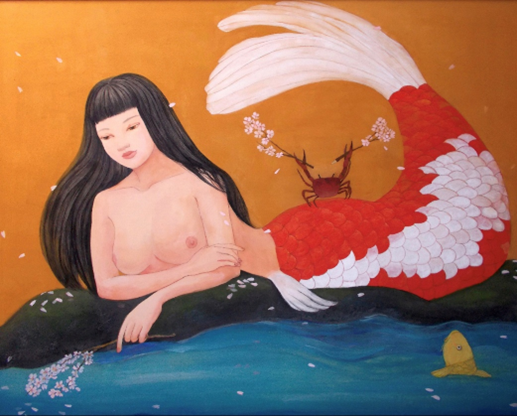
The concept of a painting comes from an inspiration
What I value most in the drawing stage is inspiration.
After making a rough sketch, I research the motif’s origin and folklore, amassing more information to complete a rough sketch of the picture I want to draw. Then, I gather more materials from research and conduct interviews.
Creating a rough sketch from the image in my mind
I often do the preliminary sketches at night and the main drawing in the morning. This is because I feel that I can come up with new and innovative ideas when my imagination is active. Working on the actual painting in the morning is better to do under natural light. That changes if there’s a deadline looming — then I can paint until late at night.

Breathing is essential in my art
Just like with Japanese calligraphy, it’s important to avoid mistakes when doing delicate brushwork. To avoid mistakes, I take care to make sure I’m breathing properly.
I can draw a smooth line by exhaling while moving the brush, and I breathe in rhythm as I draw the lines. My lines are smooth if I’m conscious of my breathing, but if I’m not feeling great, it comes out in my drawings. If my breathing becomes irregular and my lines aren’t as smooth, that’s when I know I should pay more attention to my physical condition.
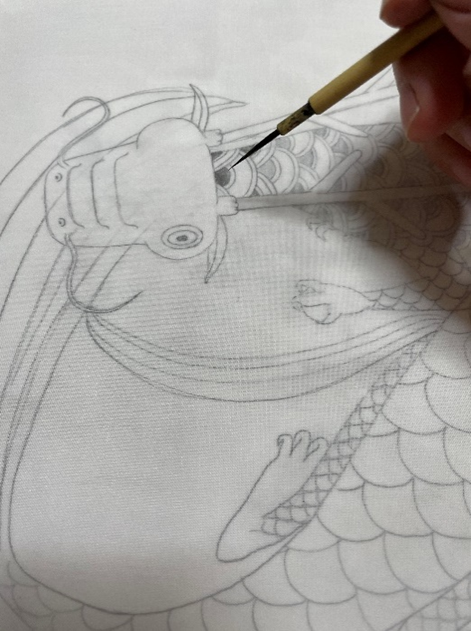
Using different types of support materials
I use Nihonga paint materials such as Suihi-enogu (mud pigment) and Iwa-enogu (mineral pigment), and mix in glue. I use washi and art cloth as supports. I use washi because I want to bring out a texture that retains ink lines. If I’m going to use a lot of pigments or gold leaf, I paint on reinforced art cloths (supports made of polyester cloth lined with paper, manufactured by specialty Nihonga painting stores)
(interviewed by FFD editorial team)
Description of Rie Saito’s work Waku wo Koete (Breaking the Frame), Nihonga
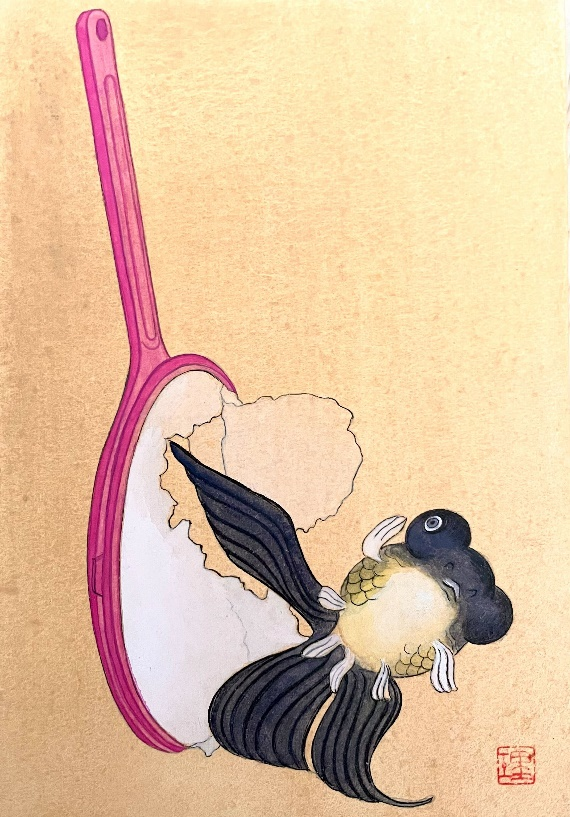
The history within this work dates back to the Edo period. Goldfish were imported from China in the Muromachi era, and were considered a luxury fish. In the Edo era, it became more commonplace and thus the game of kingyo-sukui (Scooping Goldfish) was born. It’s said that people started scooping with paper scoops from the Meiji era.
Kingyo-sukui has appeared in various works that depict fun summer traditions, including many Ukiyo-E prints. The image evokes the scene of a fun fair, but it’s probably not a fun experience for the goldfish itself. Rie Saito has said that her art is formed through her imagination, late at night.
“I don’t want to stay in the frame!”
The black bullfinch escapes from a poi (paper scoop). The hand holding the poi isn’t shown here. It’s as if the painting symbolizes the importance of freedom and the strength of the fish’s will, the desire to “go through the frame” before the hand appears to force it back inside.
(description by FFD editorial team)
Rie Saito, Artist Bio
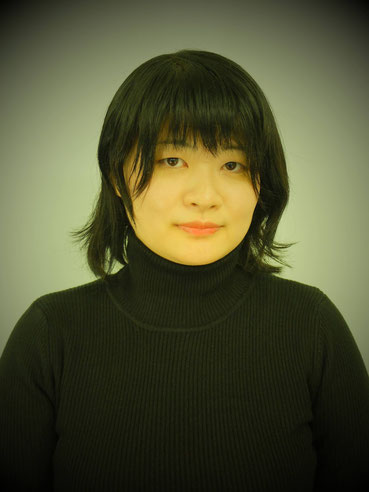
1990 Born in Kita-ku, Tokyo
2014 Entered Kyoto University of the Arts, Faculty of the Arts Correspondence Education
2016 The 33rd FUKUI Thumbhole Art Exhibition, Honorable mention
The 11th Tsuki-no-Art Exhibition , Keihanna Commemorative Park, Tsuki-no-Niwa Gallery, Honorable mention
2017 Tokyu Den-en Toshi Line 27 Station Exhibition ~Tale of 27 train lines~, Tokyu Department Store, Tama Plaza
East Asia Culture City 2017 Kyoto Partnership Program, Asian Corridor, Contemporary Art Department Special Cooperative Projects, Kyoto Student Art Auction, Honorable mention
The 43rd Contemporary Children’s Art Exhibition, Tokyo Metropolitan Art Museum, Honorable mention
2018 Asia Design Art Exhibition Phnom Penh, Royal University of Phnom Penh Kizuna Hall
KENZAN, Tokyo Metropolitan Theatre
The 44th Contemporary Children’s Art Exhibition, Tokyo Metropolitan Art Museum, Rookie of the Year award
The 6th MVW Exhibition, Fukuya Hatchobori Main Building
2019 Gold and Silver Leaf Exhibition, Hanshin Umeda Main Building
New Green Art Fair 5 Continents 5 Colors, Hilltopia Art Square
Art Sekigahara ~Osaka Summer Campaign~ , Hanshin Umeda Main Building
The 45th Contemporary Children’s Art Exhibition, Recommended society member, Tokyo Metropolitan Art Museum,
2020 Graduated from Kyoto University of the Arts, Faculty of the Arts, with a major in Nihonga
Eleven Girls Art Collection Exhibition, Hanshin Umeda Main Building
Eleven Girls Art Collection Exhibition, Fukuya Hatchobori Main Building
The 46th Contemporary Children’s Art Exhibition, Recommended society member, Tokyo Metropolitan Art Museum
2021 Grand EGC, Hilltopia Art Square
NEXT GENERATIONS Exhibition, Fukuya Hiroshima Station Store, Hiroshima
The 47th Contemporary Children’s Art Exhibition, Recommended society member, Tokyo Metropolitan Art Museum
2022 Tiger and Cat Exhibition, Isetan Urawa Store
Eleven Girls Art Collection Exhibition, Fukuya Hatchobori Main Building
Grand EGC, Hanshin Umeda Main Building
Details of Rie Saito’s exhibition
Coming soon
